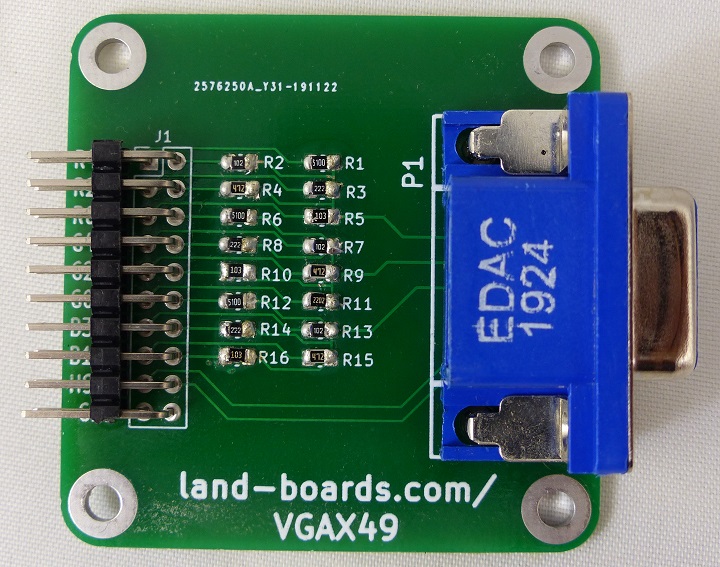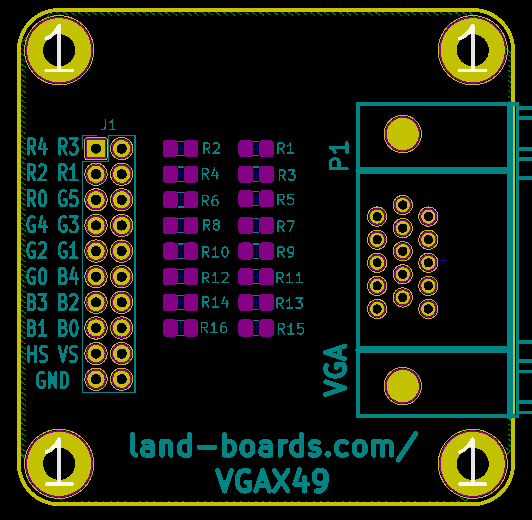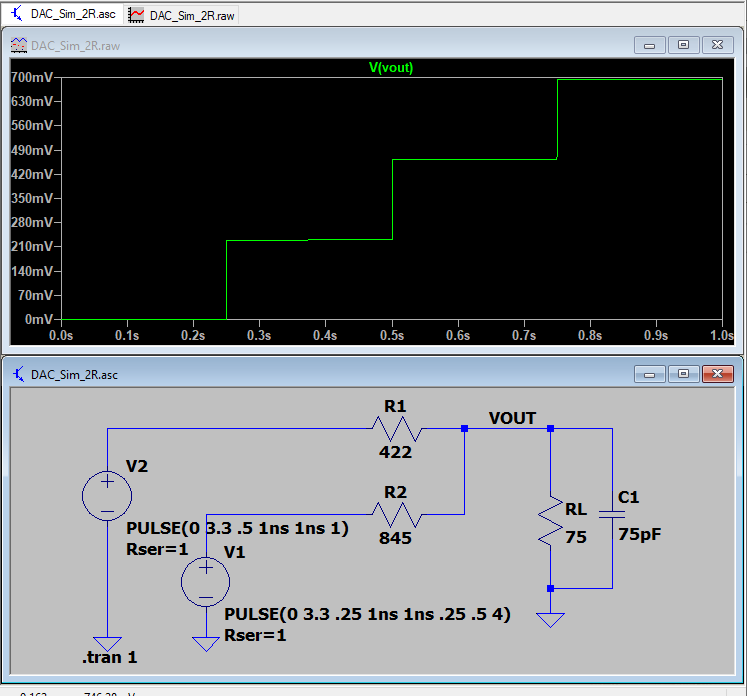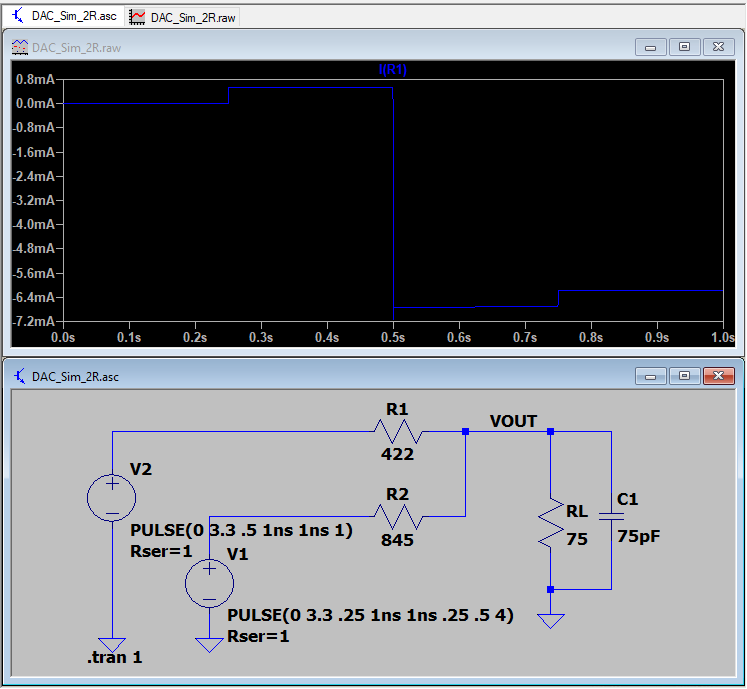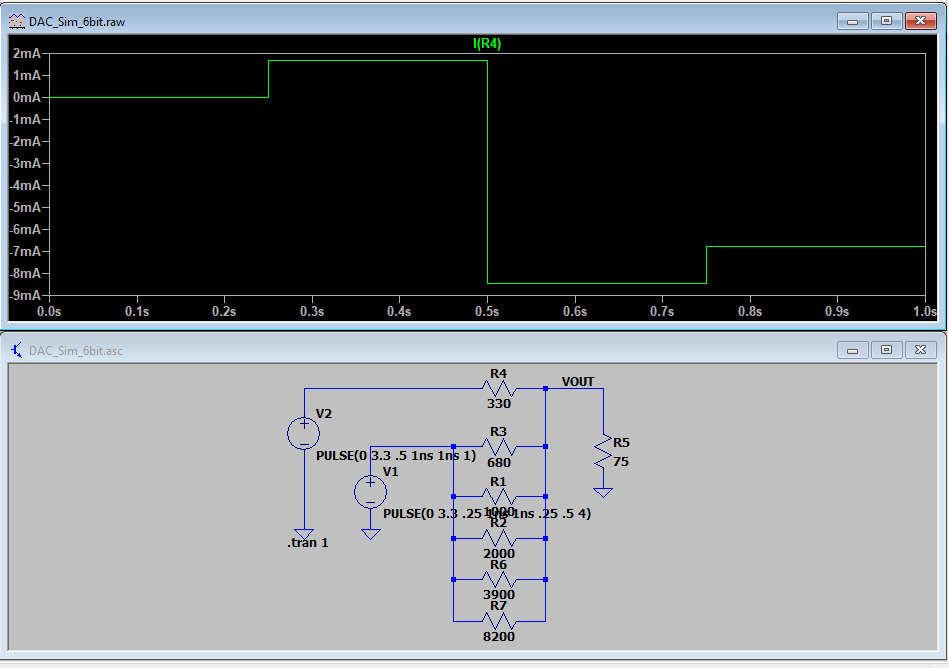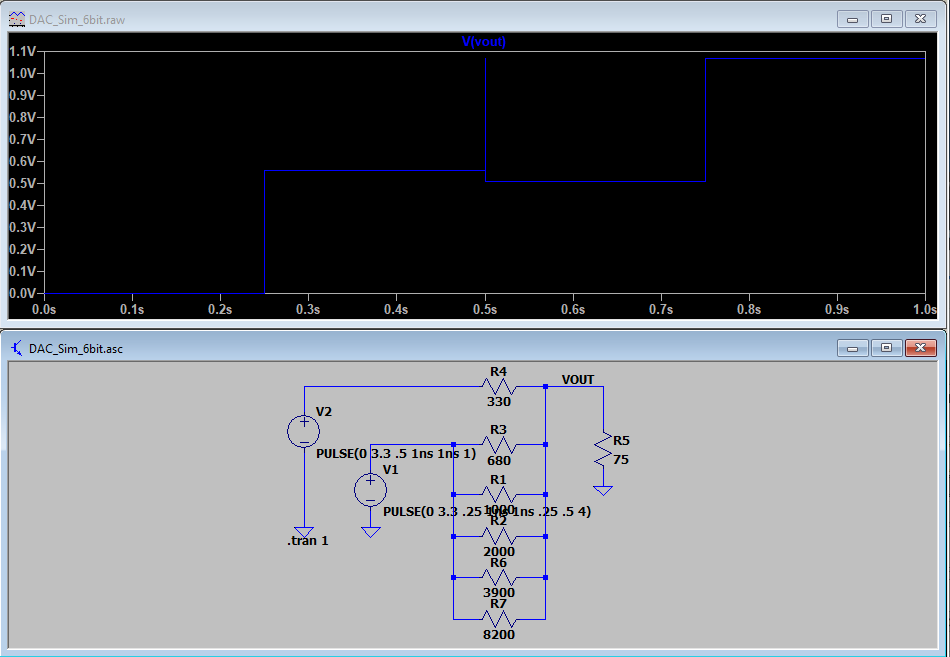Difference between revisions of "VGAX49"
Jump to navigation
Jump to search
Blwikiadmin (talk | contribs) |
Blwikiadmin (talk | contribs) |
||
| Line 71: | Line 71: | ||
[[File:VGA_Sim_2R_Voltage_6_res.PNG]] | [[File:VGA_Sim_2R_Voltage_6_res.PNG]] | ||
| − | == | + | == VGA - Ideal Drive 2:2:2 Case == |
| − | * | + | * ESP32 has a 3.3V driver which can drive more than 10 mA |
| − | ** | + | * Ideal case drive current |
| − | ** | + | ** 0.7V into 75 Ohms = 9.33 mA |
| − | * | + | * R-2R values |
| − | * | + | ** Ideal resistor values are 417.9 ohms and 835.7 ohms |
| − | + | ** [http://www.brannonelectronics.com/images/STANDARD%20VALUE.pdf Standard value 1% resistors] | |
| − | * 0. | + | ** 1% standard values are [https://www.mouser.com/ProductDetail/652-CR0805FX-4220ELF 422 (Mouser)], [https://www.mouser.com/ProductDetail/603-RC0805FR-07845RL 845 (Mouser)] Ohms |
| + | *** Get closest values | ||
| + | *** 0V, 0.228V, 0.460V, 0.693V | ||
| + | * Voltage steps are: | ||
| − | [[File: | + | [[File:VGA_Sim_2R_Voltage.PNG]] |
| − | [[File: | + | * Current steps are: |
| + | |||
| + | [[File:VGA_Sim_2R_Current.PNG]] | ||
=== Ideal Drive 2:2:2 Case === | === Ideal Drive 2:2:2 Case === | ||
Revision as of 21:46, 18 February 2020
Contents
Features
- Digital VGA adapter
- 16-bit digital video
- 5:6:5 (R:G:B) mapping (maximum)
- 2:2:2 (R:G:B) mapping (option)
- Uses summing resistors
- DB-15F connector
- 49x49mm ODAS form factor
- Mounting holes
Connectors
J1 - Digital Connections
P1 - VGA connector
Simulation
- Each color is independently driven and can be considered individually
- Critical design criteria is output voltage and current capability of the driving part
- Use common value, 5% resistors
- Each resistor is about 2X the value of the previous resistor
- 1V is drive level for VGA specification
- VGA presents a 75 Ohm load
- 1V at 75 Ohms is 13.3 mA
- Series resistors present a voltage divider between the resistors on the card and the VGA load
- The resistor with the smallest resistance value has larger current from the source device pin
- Current switches from source to sink depending on the voltages on the other resistors
- Each resistor is 2X the value of the previous resistor
- Too much effort is put into using precision resistors - the human eye is not that picky
2:2:2 Resistor Simulation
- ESP32 has a 3.3V driver which can drive more than 10 mA
- Ideal case drive current
- 0.7V into 75 Ohms = 9.33 mA
- R-2R values
- Ideal resistor values are 417.9 ohms and 835.7 ohms
- Standard value 1% resistors
- 1% standard values are 422 (Mouser), 845 (Mouser) Ohms
- Get closest values
- 0V, 0.228V, 0.460V, 0.693V
- Voltage steps are:
- Current steps are:
5:6:5 Resistor Simulation
- Assumptions
- 3.3V Drive out of FPGA
- 8 mA max drive current (typical FPGA drive current)
- Using common value, 5% resistors
- 330 Ohm series resistor into a 75 Ohm load is 8.15 mA (close enough to max of FPGA)
- Voltage with 330/75 ohm voltage divider is 0.61V - not full brightness
- Next standard value from 330 ohms is 680 ohms
- Voltage is 0.83V - better brightness
- Voltage with all 6 resistors (Green case) is 1.07V (full brightness)
- Simulation uses the same 4 value steps (real case would have 2^5 or 2^6 steps)
VGA - Ideal Drive 2:2:2 Case
- ESP32 has a 3.3V driver which can drive more than 10 mA
- Ideal case drive current
- 0.7V into 75 Ohms = 9.33 mA
- R-2R values
- Ideal resistor values are 417.9 ohms and 835.7 ohms
- Standard value 1% resistors
- 1% standard values are 422 (Mouser), 845 (Mouser) Ohms
- Get closest values
- 0V, 0.228V, 0.460V, 0.693V
- Voltage steps are:
- Current steps are:
Ideal Drive 2:2:2 Case
- Ideal case drive current
- 1V into 75 Ohms = 13.33 mA
- 3.3V driver which can drive more than 10 mA
- 1% resistors
- Get closest values
- R-2R values
- 2/3 of the drive comes from the smaller resistor
- Ideal resistor values are 261, 523 ohms
- 0V, 0.331V, 0.661V, 0.992 V
